Entries tagged with “coyotes”.
Did you find what you wanted?
Fri 7 Jan 2022
Caveat lectorem: When readers submit comments, they are asked if they want to receive an email alert with a link to new postings on this blog. A number of people have said they do. Thank you. The link is created the moment a posting goes online. Readers who find their way here through that link can see an updated version by simply clicking on the headline above the posting.
This is a belated review of an entertaining linguistic book, A Charm of Goldfinches and Other Wild Gatherings. It was originally published five years ago by Ten-Speed Press. My wife Lynn gave it to me for Christmas. The author, Matt Sewell, is a Canadian ornithologist, illustrator, and artist who has exhibited in London, Manchester, New York, Tokyo, and Paris.

As most of us know, a group of geese is called a “gaggle” but if the geese are flying in formation, the proper term is “skein,” writes Sewell. The term “comes from an old French word for ‘V’ Formation.”

Some group names are grim but accurate. Here a “wake” of vultures divvy up a skunk killed by an owl.

Virtually every night at Mitchell cabin we can hear a “band” of coyotes howling.
Groups of coyotes are called “bands” although to my mind, “choirs” would be more accurate. Sewell notes that “outside of their guarded family units, coyotes hang together in unrelated gangs, scavenging and doing whatever coyotes do.”

A “sulk” of foxes atop a shed at Toby’s Feed Barn. These were spotted by postal staff outside a postoffice window.

A “plague” of rats. Given my recent experience with roof rats, I would second the group name “plague.” Roof rats found their way into my car’s engine compartment around Christmas and chewed wiring, piled up debris, and damaged the car’s computer. The final tab at garages in Point Reyes Staton and Santa Rosa to repair the damage came to more than $2,500.

A “trip” of rabbits.
Sewell frequently indulges his ironic sense of humor. Describing how groups of rabbits came to be called “trips,” Sewell writes: “Now, some of you may be thinking: the trip would be to follow the white rabbit down the rabbit hole. Â Sadly not: this term is from the 15th century, not the 1960s Jefferson Airplane lyric, or even Lewis Carroll’s Alice in Wonderland, which inspired the song. It is, in fact, about as psychedelic as a turnip patch.
“A colony of rabbits is a flighty bunch, not surprisingly, as the whole world is their enemy…. They are rarely safe for long, not when they’re hunted by hawks and owls, weasels, foxes, domestic pets, and humans, to name just a few.”
As noted previously, “jackrabbit” is short for “jackass rabbit,” a nickname it got because of its ears.
A “ lounge” of lizards. This is a blue-belly lizard on the wall of our cabin.
lounge” of lizards. This is a blue-belly lizard on the wall of our cabin.
Lizards are cold-blooded “so they need to warm up from the sun or on warm stones.”
“It’s this lounging that gets them into trouble though as lizards are easy prey in this laid-back state.
“If they are cruelly snatched, lizards at least have a last-gasp mechanism for freedom: they can release their tail, which will wriggle around in the predator’s mouth, confusing the daylights out of it while the lizard makes a dash for the undergrowth.”
I hope it gets there safely.
Thu 28 Jan 2021
Posted by DavidMitchell under Uncategorized
[2] Comments
In the words of the poet Ezra Pound (1885-1972), “Winter is icumen in,/ Lhude sing Goddamm,/ Raineth drop and staineth slop,/ And how the wind doth ramm!/ Sing: Goddamm.”

In Inverness, 2.5 inches raineth Tuesday night with the wind ramming hard. On Laurel Avenue in Inverness Park, the wind blew down a tree that crushed contractor David Cordrey’s work van (seen here). In the San Geronimo Valley, winds gusted to 73 mph in Woodacre and 72 mph in Lagunitas. A travel-trailer occupant in Lagunitas, Jay Cimo, was knocked unconscious and suffered a brain injury when the wind toppled a tree onto the trailer.

In Inverness, a falling tree also destroyed a footbridge beside Inverness Way. The wind gusted to 59 mph in Inverness. The gusts brought down power lines in both Inverness and Bolinas.

Before the storm, a family of raccoons showed up on the deck at Mitchell cabin, so I gave them handfuls of kibble.

This, in turn, brought in a fox who dined alongside the raccoons.

The local fox is fun to look at, but he has a bad habit of marking his territory by peeing on our morning San Francisco Chronicle, which thankfully comes in a plastic bag. Obviously removing the newspaper from the bag must be done with care. Equally unsettling, the fox has taken to pooping on our deck at night. Better on the deck than the newspaper, for I certainly wouldn’t want to deal with sh*tty-fox news morning after morning.

Other members of the dog family (Canidae) are coyotes such as this one walking up to a patch of coyote brush near Mitchell cabin. We hear them most nights but see them only occasionally. What we are starting to see more often is coyote scat in the field below the cabin.

I’m certainly glad it’s in the grass and not on our deck or newspaper.

Worried that high winds could topple two dead pines along our driveway, I recently hired Nick Whitney and his Pacific Slope crew to cut them down and buck them up for firewood. Our neighbors Skip and Renée Shannon followed suit by having yet another neighbor, George Grim Jr., cut a tree, buck, and split it. Grim also split the trees I had cut down. With the Shannons contributing their tree (piled above), Lynn and I are accumulating quite a firewood collection, including three smaller stacks.

For the most part we use a woodstove to heat the cabin, so the bonanza of logs is most welcome.

Enjoying the warmth, Lynn sits by the fire with Newy, the stray cat we took in last year.
Sat 29 Feb 2020
Posted by DavidMitchell under West Marin nature, Wildlife
Comments Off on Animal tales of past developments
Caveat lectorem: When readers submit comments, they are asked if they want to receive an email alert with a link to new postings on this blog. A number of people have said they do. Thank you. The link is created the moment a posting goes online. Readers who find their way here through that link can see an updated version by simply clicking on the headline above the posting.

A coyote prowling, appropriately enough, near our coyote brush.
Coyotes were loudly howling Thursday night down at the foot of our cul de sac, creating the impression that something big was occurring. But as the Human-Wildlife Interactions journal explained in 2017, some mistakenly believe howling indicates that a group of coyotes has made a kill.
Coyotes howl for various reasons, and it is not likely because they have downed prey. Doing so would draw attention and might attract competing coyotes or other predators to their location, which is not something a hungry coyote would want to do. Coyotes howl and yip primarily to communicate with each other and establish territory. They may bark when they are defending a den or a kill. When coyotes are noisy, it often creates an exaggerated impression as to how many are on hand, largely because of the mixing of howls and yips.
There were no coyotes in West Marin for 40 years because of poisoning by sheep ranchers in northwest Marin and southern Sonoma counties. However, coyotes never disappeared from northern Sonoma County, and after the Nixon Administration banned the poison 10-80, they started spreading south and showed up here again in 1983. Since then coyotes have put an end to well over half the sheep ranching around Marshall, Tomales, Dillon Beach, and Valley Ford.

Three horses belonging to Point Reyes Arabian Adventures grazing outside our bedroom window last week.
By chance, I’ve recently listened several times to the Irish singer Van Morrison singing his 1989 composition Coney Island. It’s a pastoral song, which seems to contain an odd reference to cocaine: “Coney Island/ Coming down from Downpatrick/ Stopping off at St. John’s Point/ Out all day birdwatching/ And the crack was good.”
The reality, of course, is that he’s actually saying “craic,” which is a relatively new Irish word for fun or entertainment. It was borrowed in the last century from Ulster and Scotland, where it is pronounced crack.

Jackrabbit outside Mitchell cabin.
Coney Island in Van Morrison’s song does not refer to the amusement park in Brooklyn but to an island off County Sligo on the west coast of Ireland. And here’s where the story gets interesting. By most accounts, Dutch settlers named Ireland’s Coney Island after the many rabbits found there, konijn being a Dutch word for rabbit.
In the late 1700s, a merchant ship, Arethusa, regularly sailed between Sligo and New York City. After seeing an abundance of rabbits on a New York island, Peter O’Connor, the ship’s captain, named the place Coney Island because it reminded him of the Coney Island in Sligo Bay. During the 1920s and 1930s, Coney Island, New York, became a peninsula when a creek separating it from the rest of the city was filled in.

Raccoons are nightly visitors at Mitchell cabin, and I’ve come to see at least two sides of their personalities. They’re cute and able to beg for handouts, but they get skittish if I’m too close, quickly backing away when I open a door. And that’s probably for the best. Over the years, West Marin’s raccoons have prompted numerous calls to the Sheriff’s Office from people who thought they heard a prowler on their porch or roof at night.
Skunks drop by Mitchell cabin most nights, aggressively competing with the raccoons for food. They don’t spray but forcefully shoulder aside raccoons, even though the latter are noticeably bigger. I’m fascinated by all this and find it shameful how misguided county policy towards the two species was six decades ago. In 1958, Marin County supervisors began offering $1 bounties for skunk and raccoon tails. Fortunately after three weeks, the board reversed itself and dropped the offer, not because it was cruel but because young hunters with small-bore rifles were shattering too many windows.

Despite appearances, this raccoon is not trying to look fierce. It’s merely chomping down hard on a piece of kibble.
If raccoons show up on our deck wanting to be fed and realize we don’t know they’re out there, some will make us see them through our living room windows by standing on their hind legs atop a small bench or the woodbox and staring in at us. If we still don’t see them, they often create a squeal by dragging the pads of their front paws down the glass.

Wild turkeys are native to Canada, Mexico, the American Midwest, and the East Coast but not West Marin although they are now found throughout this area. In the 1950s, the state Department of Fish and Game released some wild turkeys in Napa County because they were so popular with hunters. In 1988, Fish and Game biologists took a few birds from the Napa flock and released them on Loma Alta Ridge between Big Rock and Woodacre.
Few people hunt the turkeys these days, flocks have increased in number and size, and the turkeys have become rather bold. In 2001, two Tom turkeys went after a couple of school children riding scooters in Tomales. The children had to escape on foot, leaving their scooters behind. Now who’s doing the hunting?
Sun 13 Oct 2013
Posted by DavidMitchell under West Marin nature, Wildlife
Comments Off on A dead buck, buzzards, flies…. and who else?
Saturday morning I got a call from my neighbor Jay Haas, who told me, “If you’ve been wondering about all the vultures around here for the past day, there’s a dead deer on your side of our [common] fence. I thought you might want to snap a photo.”
I’d been over the hill all day Friday and hadn’t seen the buzzards, I replied, but I immediately went down to the fence to take some pictures. (Warning: three of the following photos are fairly grim.)

It wasn’t hard to figure out where the dead deer was. The first thing I saw was this buzzard sitting on a fence post warming itself in the morning sun and looking like the imperial eagle on Kaiser Wilhelm’s banner.

Most of the flesh, hair, and internal organs of the deer, a one- or two-year-old blacktail buck, had already been stripped from its skeleton. The bones, ears, antlers, and the hair on its head were about all that remained. There was no way to readily tell how it had died: killed by a predator, injured in traffic, wounded by a hunter, or weakened by disease.

By now the buzzards were circling overhead again, waiting for me to absent myself so they could carry on eating carrion.
Buzzard, by the way, is American English for vulture. My ornithologist friends periodically tell me I should be calling the birds vultures. Buzzard refers to a buteo hawk, they insist, not a vulture.
But that’s not what the dictionary says. My American Heritage Dictionary defines buzzard as “any of various North American vultures, such as the turkey vulture.”
The use of buzzard to mean buteo hawk, the dictionary adds, is “chiefly British,” and I don’t live in England. I live in the American West, and when a fellow here calls a disreputable man an old buzzard, he sure as hell doesn’t mean an old buteo hawk. He means an old carrion eater.

Two buzzards keep an eye on the carcass as two others strip some remaining bits of meat from the skeleton.
 Buzzards aren’t the only creatures, of course, that dine on carrion, and it wasn’t obvious who had eaten most of the deer.
Buzzards aren’t the only creatures, of course, that dine on carrion, and it wasn’t obvious who had eaten most of the deer.
Foxes, raccoons, and coyotes eat roadkill and other dead animals.
Mountain lions will also eat carrion when extremely hungry but normally prefer fresh meat.
Smaller carrion eaters often start with the eyes and anus because they provide easy access to the rest of the body. These holes also open passages for flies.
The role of carcasses in a fly’s lifecycle is remarkable. The average lifespan of houseflies is only three weeks, but females can lay 900 eggs in that brief period. The eggs are laid in whatever the flies are feeding on, and within a day, the first larvae (also called maggots) hatch out. It takes less than two days for the maggots to double in size, forcing them to molt and shed their exoskeletons.
After continuing to grow, and molting two more times, the worm-like maggots dig deeper into their food supply and begin their pupa stage. The pupa develops a hard shell and inside it the appendages of an adult fly. To free itself from the shell, however, requires a strange ability. The pupa grows a bump on its head which it uses to break through the shell, after which the bump is absorbed back into the fly’s head. From a newly laid egg to an adult fly on the wing takes a week to 10 days in warm weather.

Before long five buzzards were perched on fence posts, watching two others tearing away at the carcass.

Sunday morning, I decided to take another look at the skeleton and was startled by what I saw. During the night, the buck had been dragged 10 feet uphill from the fence. Now who did that? Certainly not a buzzard, fox, or raccoon. Even stripped of most of its flesh, the skeleton was still fairly heavy.
I know of only two wild animals hereabouts with the strength to drag that much weight even a short distance: a mountain lion and a coyote. Although mountain lion tracks have been found near Mitchell cabin, there certainly aren’t many cougars hereabouts. Nor could I imagine a mountain lion going to the trouble of dragging around a skeleton that didn’t have much meat on it.
That would seem to leave one of the local coyotes as the most likely suspect. Coyotes, like mountain lions, sometimes drag their dinner to places where they can eat in private, but this coyote apparently gave up after only a few feet.
I called Jay back and asked if he had heard any coyotes howling Saturday night. He hadn’t but was as surprised as I that the skeleton had been moved.
The cause of the young buck’s death remains a sad mystery. The full variety of critters that ate its carcass is likewise a mystery. But who dragged its skeleton uphill is the biggest mystery of all.
Sun 25 Dec 2011
Two close friends from Los Angeles, Janine Warner, who reported for The Point Reyes Light when I owned the newspaper, and her husband Dave LaFontaine, have been staying here for the Christmas holidays.
On Christmas Day itself, however, some even more exotic guests showed up.
 Around noon Janine went out on the deck to enjoy the sunny Christmas Day and soon spotted a coyote in my field. Here it heads into some eponymous coyote brush.
Around noon Janine went out on the deck to enjoy the sunny Christmas Day and soon spotted a coyote in my field. Here it heads into some eponymous coyote brush.
 Immediately I hurried inside and grabbed my camera. Before long, the coyote reemerged next to my parking area. It could hear us chattering on the deck and began staring at me while I took its picture.
Immediately I hurried inside and grabbed my camera. Before long, the coyote reemerged next to my parking area. It could hear us chattering on the deck and began staring at me while I took its picture.
 The creature then looked down my driveway to make sure all was clear. Coyotes can be fierce, but they’re not foolhardy.
The creature then looked down my driveway to make sure all was clear. Coyotes can be fierce, but they’re not foolhardy.
 When it finally decided to leave, it started off at a brisk walk. Whether walking or running, coyotes are amazingly graceful.
When it finally decided to leave, it started off at a brisk walk. Whether walking or running, coyotes are amazingly graceful.

Coyotes have a walking speed that sometimes tops 20 mph while their running speed can easily top 30 mph. This coyote, however, was just meandering. It took him almost half a minute to travel 0.2 miles to the bottom end of the driveway, where he then sat down to survey the area. Before long, he had disappeared without a trace.

Less than five minutes later, as if on cue, two bucks showed up outside our kitchen window. Both were good looking animals, but the buck in the foreground had an especially regal bearing.

Accompanying the bucks were two does. Like the bucks, the does were not particularly nervous, even when I went out the back door to get a clear photo of them.
Of course, these were not the only wild animals to visit Mitchell cabin on Christmas Day. Our familiar raccoon families showed up in the evening. We fed them slices of bread, but, to save money, we’re now supplementing that with dog kibble instead of honey-roasted peanuts.
Also showing up were our usual pair of gray foxes. One is comfortable enough around us to take slices of bread from our hands. The other, however, is sufficiently skittish that most of the time we have to throw slices to him.
Having a peaceful relationship with the animals around us is key to our having a decent existence, as most religions agree. “Life is dear to the mute creature as it is to a man. Just as one wants happiness and fears pain, just as one wants to live and not to die, so do other creatures,” wrote the XIV Dalai Lama in 1967.
“There is not an animal on the earth, nor a flying creature on two wings, but they are people like unto you,” proclaims the Qur’an. “Animals, as part of God’s creation, have rights which must be respected,” Dr. Donald Coggan, the former Archbishop of Canterbury, observed. “It behooves us always to be sensitive to their needs and to the reality of their pain.”
Sun 27 Nov 2011
Posted by DavidMitchell under West Marin nature, Wildlife
Comments Off on A gallery of visits from wildlife
It’s time for another look at wildlife that have been showing up this fall around Mitchell cabin.
 Last week I reported finding coyote scat on my driveway and noted that neighbor George Stamoulis had not only found the scat on his driveway, he’d seen the critter itself ambling up Campolindo Road.
Last week I reported finding coyote scat on my driveway and noted that neighbor George Stamoulis had not only found the scat on his driveway, he’d seen the critter itself ambling up Campolindo Road.
Finally I saw the beast for myself. About 1:30 p.m. Saturday, I looked out the kitchen’s glass door just in time to see a coyote round the corner of the cabin. I grabbed my camera, went out on my deck, and managed to catch this shot of the coyote marking its territory by urinating and scratching the ground.
I get a kick out of seeing coyotes, but, of course, I’m not a sheepman. For 40 years, there were no coyotes in West Marin, but they never disappeared from Northern Sonoma County. After the federal government made ranchers stop poisoning them, coyotes began returning southward. They reached West Marin in 1983 and within the next 15 or so years wiped out a majority of sheep ranches in West Marin and Southern Sonoma County.
Along with sheep, coyotes sometimes hunt deer and not infrequently eat domestic dogs and cats. Among their most-common prey are small mammals, birds, snakes, lizards, and large insects. Traditionally diurnal, coyotes are becoming more nocturnal because of pressure from human development.

Hunting outside my kitchen window.
Last week I posted a couple of photos of a bobcat that had just shown up outside my kitchen window. Here’s a third image that shows it hunting. Bobcats’ favorite prey are rabbits and hares, but they’ll eat anything from insects to rodents to deer.

Gray foxes are omnivorous, eating fruits along with birds and small rodents. They also like cheap, white bread. Gray foxes tend to be nocturnal or crepuscular (active at dawn and twilight).
Along with the Asian raccoon dog, they are the only members of the Canidae family that can climb trees. That’s one way they can raid bird nests and avoid the coyotes.

After sizing up the situation Saturday night, a gray fox takes a slice of bread from my girlfriend Lynn’s hand.

Also visiting our deck each evening, hoping for slices of bread and honey-roasted peanuts, are two families of raccoons. While the families don’t like each other, they are at ease around us. Here a young raccoon curls up outside our kitchen door to take a nap. (Photo by Lynn Axelrod)
Tue 22 Nov 2011
When Lynn and I returned home from a visit to my optometrist in Terra Linda last week, we found a mirthful message on our answering machine from Linda Sturdivant of Inverness Park. “Hey Dave,” she said. “I want to tell you about something beautiful I saw yesterday.
“As I was leaving here, I got to the end of the levee road. At the pumpkinhouse, there is one of the most beautiful red trees you could ever see. Get a picture.”
The pumpkinhouse gets its nickname from the pumpkin displays that once were on its front porch and fence every year. If you check Janis Ceresi’s comment, she includes a link that shows what the pumpkin house used to look like on Halloween.

Wanting more information regarding the tree’s location, I called Linda back, and a friendly young woman answered. Not recognizing her voice, I asked, “Is this Linda?” She said she was. “Just where is this beautiful tree?” I asked, and she sounded confused. “Which tree?” she responded. “The one you called me about.” She then asked me, “Where are you?” and I replied, “In Point Reyes Station.”
“Well, I’m in San Francisco,” she said. We both laughed and hung up, and I called the real Linda Sturdivant.

The tree Linda saw is not the only one around here with brilliant fall colors. This allée of maple trees is across Highway 1 from Campolindo Road, where I live.
 Last week I had just started down my front steps when I heard a commotion in a pyracantha bush on Doreen Miao’s property uphill from mine. Not sure what I was seeing, I grabbed my camera and started snapping photos.
Last week I had just started down my front steps when I heard a commotion in a pyracantha bush on Doreen Miao’s property uphill from mine. Not sure what I was seeing, I grabbed my camera and started snapping photos.
 Before long the source of the disturbance became obvious when a flock of wild turkeys fluttered to the ground. What had they been doing up in the bush? I was surprised that the bush’s bitter berries are safe to eat, so I checked the Seasonal Cooking website. “Contrary to a common myth, they are not poisonous,” the site said. “Pyracantha, a relative of apples and roses, is entirely edible.” In fact, you can use the berries to make preserves and jelly.
Before long the source of the disturbance became obvious when a flock of wild turkeys fluttered to the ground. What had they been doing up in the bush? I was surprised that the bush’s bitter berries are safe to eat, so I checked the Seasonal Cooking website. “Contrary to a common myth, they are not poisonous,” the site said. “Pyracantha, a relative of apples and roses, is entirely edible.” In fact, you can use the berries to make preserves and jelly.
 As we head toward winter, a variety of wildlife has begun hanging around just outside the cabin. I photographed this blacktail buck just below our deck. In addition, a doe and her fawn are so comfortable here that I can walk within a few yards of them.
As we head toward winter, a variety of wildlife has begun hanging around just outside the cabin. I photographed this blacktail buck just below our deck. In addition, a doe and her fawn are so comfortable here that I can walk within a few yards of them.

Last week I was looking out my kitchen window when I spotted this bobcat looking back at me.
 It’s been awhile since I’ve seen a bobcat so close to Mitchell cabin, but it didn’t seem to mind my presence and soon resumed hunting.
It’s been awhile since I’ve seen a bobcat so close to Mitchell cabin, but it didn’t seem to mind my presence and soon resumed hunting.
Another predator that I haven’t seen for more than a year showed up this week. I didn’t see the coyote, but I found its scat in my driveway. Neighbor George Stamoulis found a fair amount of coyote scat in his driveway and saw the animal itself moseying up Campolindo Road.
Last night, Lynn and I spotted still another creature that hasn’t been around for months. A young possum showed up on my deck to eat the remainder of peanuts Lynn had put out for raccoons. Raccoons and grey foxes have become so common during the evening at Mitchell cabin that they’ve become fairly comfortable with us. We can feed them slices of bread by hand with no problem.
I’ll close on a linguistic fact I learned from the WildCare magazine this week. There is a name for the burbling sounds mother raccoons and their young make among themselves. It’s called trilling, as in Lionel, and we’ve heard it many times.

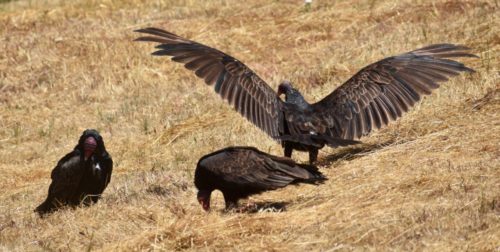
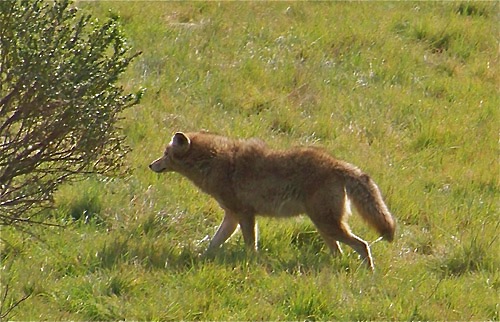
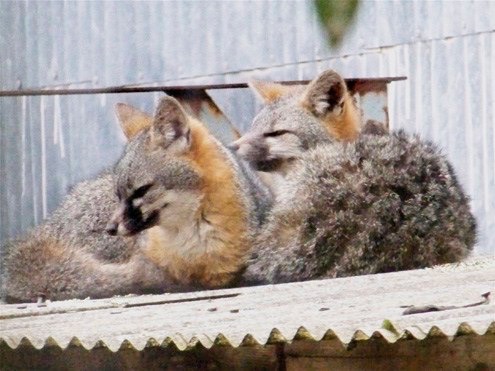
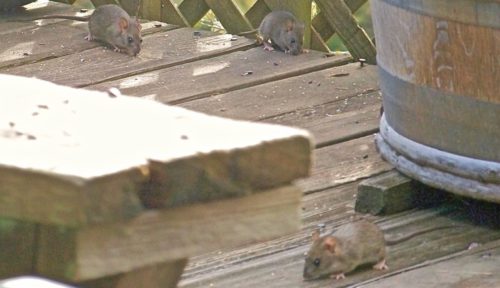
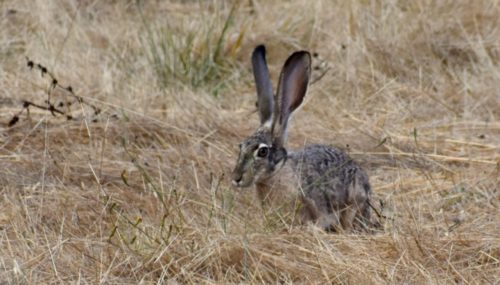
 lounge” of lizards. This is a blue-belly lizard on the wall of our cabin.
lounge” of lizards. This is a blue-belly lizard on the wall of our cabin.
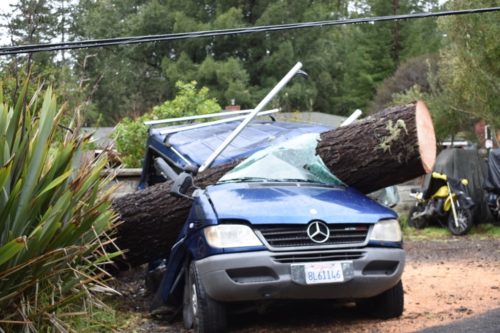
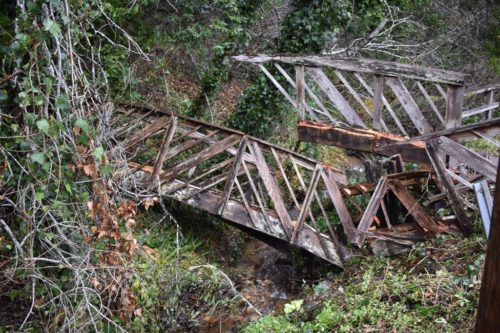
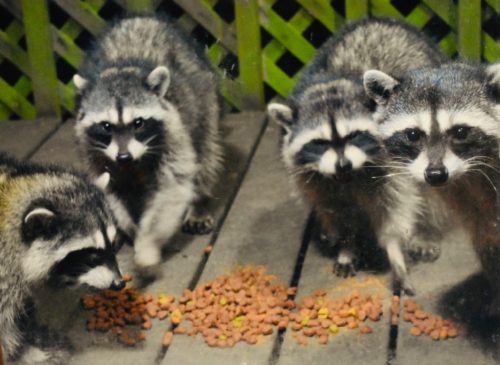
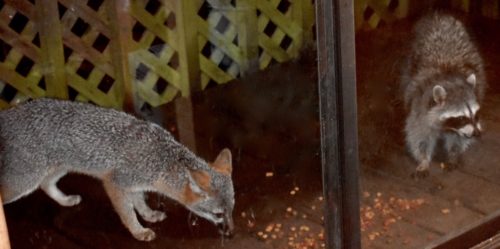
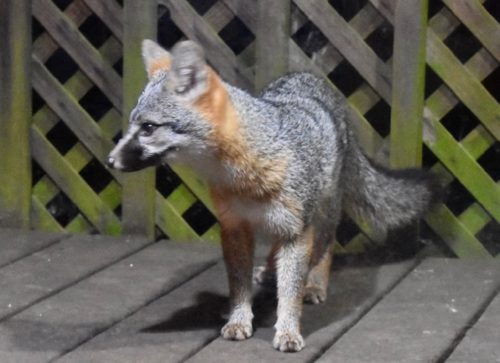
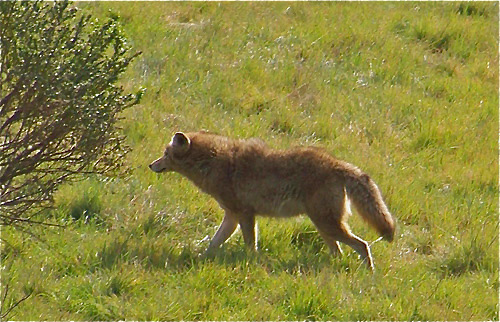
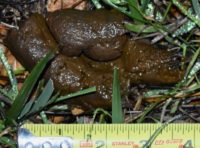
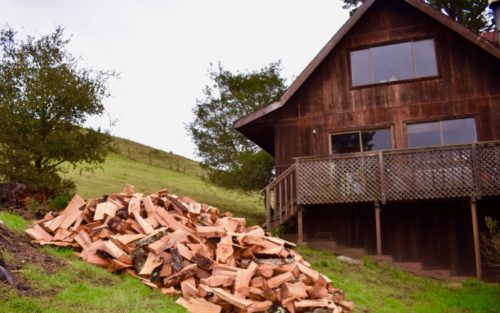
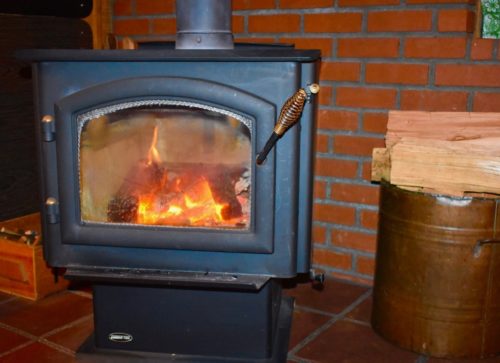
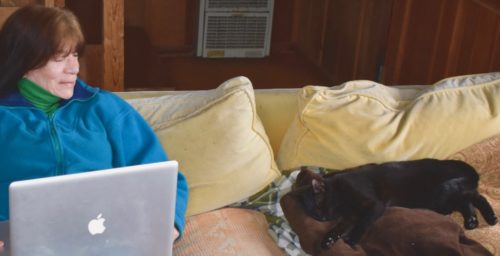

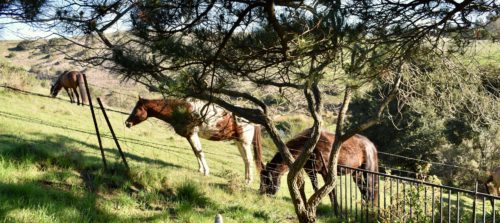
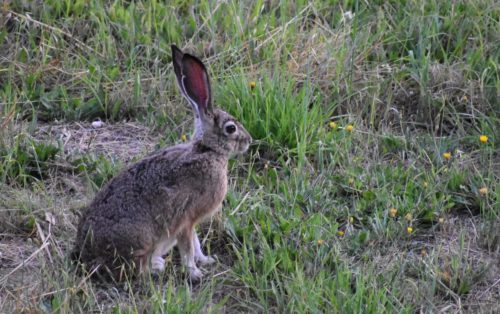
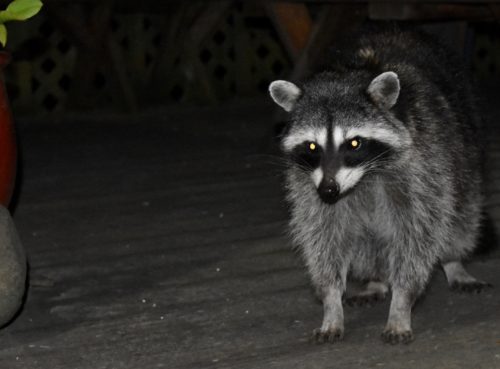
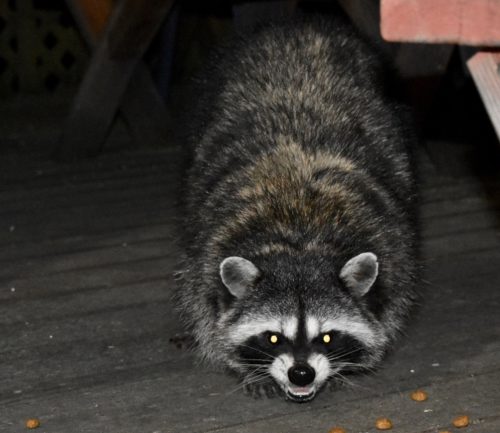
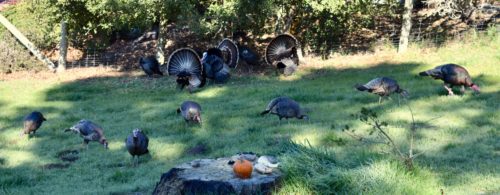







 Around noon Janine went out on the deck to enjoy the sunny Christmas Day and soon spotted a coyote in my field. Here it heads into some eponymous coyote brush.
Around noon Janine went out on the deck to enjoy the sunny Christmas Day and soon spotted a coyote in my field. Here it heads into some eponymous coyote brush.
















